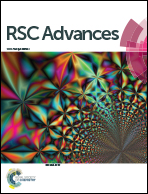Porous metal–organic framework MIL-100(Fe) as an efficient catalyst for the selective catalytic reduction of NOx with NH3†
Abstract
The development of an efficient catalyst with excellent catalytic activity and high SO2 resistance at low temperatures (<300 °C) remains a challenge for the selective catalytic reduction (SCR) reaction. In this study, we report that MIL-100(Fe) is an alternative catalyst for the SCR of NOx with NH3, and it exhibits higher NOx conversion than the conventional V2O5–WO3/TiO2 catalyst below 300 °C. In addition, the effect of H2O and SO2 on the catalytic activity is reversible, and NOx conversions are recovered after ceasing the flow of SO2 and H2O. In situ diffuse reflectance infrared Fourier transform spectroscopy results indicate that both ionic NH4+ and coordinated NH3 existed on MIL-100(Fe) and that the reaction primarily followed the Langmuir–Hinshelwood mechanism, in which NH4+ reacts with NO2 formed from NO oxidation over iron sites. Furthermore, the redox properties of the iron species (Fe3+ + e− ↔ Fe2+) could play a significant role in activating the reactants.


 Please wait while we load your content...
Please wait while we load your content...